If you’re planning a trip to Japan and love marine life, you should add visiting an aquarium to your list. Some of the best aquariums in the world are in Japan.
They showcase a diverse range of sea creatures and breathtaking exhibits. You can discover all sorts of aquatic wonders, from colorful fish to fascinating mammals.
Aquariums in Japan offer unique experiences that go beyond just viewing sea life.
Many of these places also focus on conservation and education, helping you learn more about the ocean and its inhabitants.
Whether you’re traveling solo or with family, these aquatic attractions promise a memorable outing.
Osaka Aquarium Kaiyukan
Osaka Aquarium Kaiyukan is one of Japan’s largest aquariums.
It is located in the vibrant Minato Ward and offers a fascinating journey through marine life.
You can see a variety of sea creatures, including sharks, stingrays, and colorful fish.
The aquarium features a unique design that mimics the Pacific Ocean’s ecosystem.
Each area highlights different marine habitats, making it an educational experience.
As you walk through, you’ll find large tanks that provide close-up views of the animals.
Kaiyukan also has special exhibits and events throughout the year.
Don’t miss the opportunity to see feeding sessions and learn more about the animals.
It’s a great place for both kids and adults to enjoy.
The aquarium is open from the morning until the evening, making it easy to fit into your day.
Just remember to check for ticket availability, especially during busy times.
Rating: 4.4 (46,000 reviews)
Location: 1 Chome-1-10 Kaigandori, Minato Ward, Osaka, 552-0022, Japan
Website: Visit Website
Aquarium Experiences
Visiting an aquarium is not just about observing fish.
You can enjoy interactive tours and participate in feeding sessions that make the experience memorable.
Interactive Tours
Interactive tours allow you to dive deeper into the marine world.
At places like the Okinawa Churaumi Aquarium, you can explore behind-the-scenes areas with knowledgeable guides.
These tours often feature close-up views of stunning marine life, including dolphins and coral reefs.
You might even get to touch some sea creatures in specially designed touch tanks.
Many aquariums also incorporate technology.
For instance, augmented reality experiences might let you see how various marine animals behave in their natural habitats.
These engaging tours are perfect for all ages, making learning about sea life fun.
Feeding Sessions
Feeding sessions at aquariums offer a hands-on experience that you shouldn’t miss.
In venues like the Port of Nagoya Public Aquarium, you can observe the excitement during feeding times.
Whether it’s penguins, sharks, or sea turtles, seeing them eat is fascinating.
Some aquariums allow you to participate in these sessions.
You might be able to toss food to certain animals under the guidance of trained staff.
This opportunity brings you closer to the creatures and helps you understand their diets.
Feeding sessions create a connection between you and the aquatic animals.
It’s a thrilling way to appreciate the ocean’s wonders while learning about animal care as well.
Marine Life Education

Aquariums in Japan play a key role in educating visitors about marine life.
They showcase a variety of species and promote conservation efforts.
Understanding these elements enhances your experience and awareness of ocean ecology.
Species Diversity
When you visit aquariums like the Okinawa Churaumi Aquarium, you’ll find over 800 species of marine life.
From vibrant coral reefs to deep sea creatures, there’s so much to explore.
You can see:
- Whale sharks: The largest fish in the world, they thrive in warm waters.
- Manta rays: Known for their graceful movements.
- Tropical fish: Their bright colors make them popular among visitors.
These diverse species highlight the complexity of ocean ecosystems and foster a deeper appreciation for marine biodiversity.
Conservation Programs
Many Japanese aquariums run programs dedicated to conservation.
For instance, the Port of Nagoya Public Aquarium focuses on educating visitors about local marine environments.
They often host events that emphasize protecting ocean habitats.
Programs may include:
- Rescue and rehabilitation: Helping injured marine animals.
- Research initiatives: Studying local species to support conservation.
- Community outreach: Workshops and lectures to raise awareness.
Learning about these programs can inspire you to support marine conservation efforts, making your visit meaningful beyond just entertainment.
Frequently Asked Questions

You might have a few questions about visiting aquariums in Japan.
Here’s some helpful info that can guide your next adventure.
Which aquarium in Japan is a must-visit for families with kids?
Osaka Aquarium Kaiyukan is a fantastic choice for families.
It has interactive exhibits and fun activities that kids will love.
The variety of sea life makes it exciting for all ages.
Can you find whale sharks in any Japanese aquariums?
Yes, you can see whale sharks at Okinawa Churaumi Aquarium.
This aquarium has the famous Kuroshio Tank, which is home to several whale sharks swimming alongside other marine creatures.
What’s the most impressive aquarium to check out in Tokyo?
The Tokyo Sumida Aquarium is often regarded as one of the best in the city.
It features beautiful displays of jellyfish, penguins, and a large range of fish, making it a perfect spot for sea life lovers.
Where can you find the largest aquarium in Japan?
The largest aquarium in Japan is Osaka Aquarium Kaiyukan.
It has a total of 75 tanks and holds millions of gallons of water.
You won’t want to miss the massive exhibits here.
What makes the famous aquarium in Japan stand out from the rest?
Okinawa Churaumi Aquarium is known for its size and impressive variety.
It offers a unique experience with its giant tanks.
The opportunity to see whale sharks is a big draw for visitors.
Between Tokyo and Osaka, which city has the better aquarium experience?
Both cities have unique aquariums.
However, Osaka Aquarium Kaiyukan tends to be more popular than Tokyo’s aquariums.
This is due to its scale and diverse exhibits.
Many choose Osaka for a bigger adventure.


